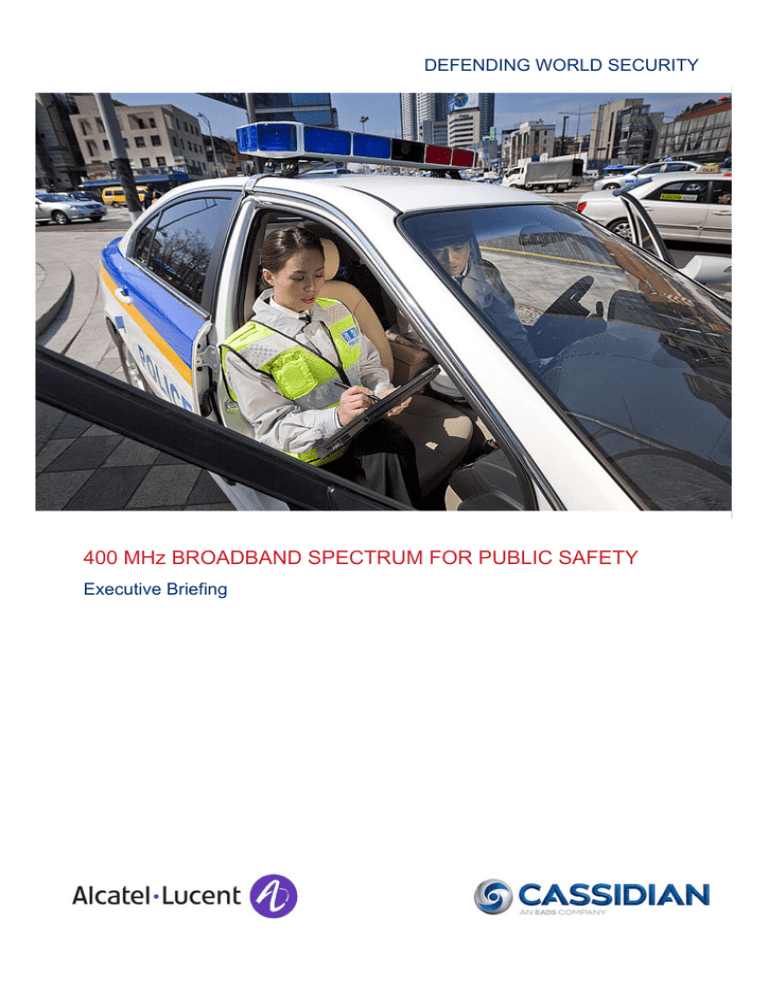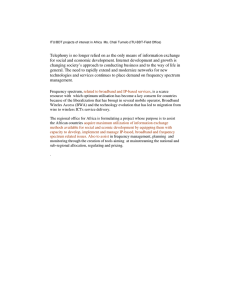
DEFENDING WORLD SECURITY
400 MHz BROADBAND SPECTRUM FOR PUBLIC SAFETY
Executive Briefing
2
400 MHz broadband spectrum for public safety
Contents
The demand for mission-critical data .................................................................................. 3
New possibilities for professional users ................................................................................... 3
More spectrum needed – where to find it?.......................................................................... 4
Larger cells – fewer base stations – benefits...................................................................... 5
Conclusions ........................................................................................................................... 5
Executive briefing
3
The demand for mission-critical data
In the challenging economic climate, governments are keen to look at mobile data
services to improve their operations. When
authorities’ daily operations start depending
on data, mobile data communication networks have to be mission critical – secure,
reliable and always available.
Evolution to broadband is necessary for introducing new info-centric operations (that
take advantage of digital information such as
images and video, for example).
While current ETSI (European Telecommunications Standards Institute) SRDoc (System
Reference Document) for PPDR (Public Protection and Disaster Relief) identified needs
for 2x10 MHz of new spectrum for mobile
broadband data, and the International Telecommunication Union (ITU) has started work
towards its World Radiocommunication Conference 2015 (WRC-2015) PPDR agenda
item 1.3, one should understand that these
are long term goals set for the next 10-15
years. Even so, governments expect to have
first implementations of secure mobile data
services much sooner.
New possibilities for professional users
With the challenge to identify new spectrum,
the foreseen availability of high power LTE
(Long Term Evolution) broadband technology
in the 400 MHz spectrum offers new possibilities, through Cassidian - Alcatel-Lucent partnership. The innovative, integrated LTE 400
PMR solution offers a pragmatic way to introduce broadband PPDR capacity in the tuning
range 380-470 MHz. This approach leverages the LTE technology.
LTE is the global 4G standard, and it brings
great performance in terms of throughput and
latency (less than 10 ms). Also, LTE is based
on IP, so integrating video, data, and voice
applications is easy while controlling the
Quality of Service of each individual flow. The
integrated LTE 400 PMR solution uses channel widths of 1.4 MHz, 3 MHz or 5 MHz depending on spectrum availability that are deployed with a frequency reuse of 1.
Moreover, the Cassidian – Alcatel Lucent solution provides a platform for evolving today’s
TETRA and TETRAPOL networks toward a
common professional broadband standard
and ecosystem, ready to host future mission
critical interoperable voice and data applications. The solution will be ready for field trials
during 2012.
4
400 MHz broadband spectrum for public safety
More spectrum needed – where to find it?
In North America, a dedicated 700 MHz band
has been reserved and allocated for Public
Safety use. It was allocated next to a commercial band to:
•
Leverage the commercial ecosystem and
•
Further increase interoperability between
fragmented jurisdictions by a national
broadband strategy and governance.
However, because this is a higher frequency
band and low power devices are used, 3-4
times more base station sites are needed to
reach the equivalent of APCO P25 Land Mobile Radio (LMR) voice systems’ coverage.
In Europe, Public Safety networks have been
implemented in the 380 – 400 MHz band.
This was done with a national strategy and
coverage leveraging decision made in the
1990's by NATO to re-allocate 2x5 MHz for
Public Safety use across the European Union. Such an infrastructure, all the backbones
and sites represent a huge asset on which to
build future communications with a 1-1 site
reuse strategy.
In the Asia-Pacific area, most Public Safety
networks are built in the 400 MHz or in the
800 MHz band, while Mainland China uses
350 MHz frequencies.
-
400 MHz bands are available for Public Safety or Professional Mobile Radio in some countries, and they are
occupied
-
The 700 MHz range was identified for
mobile use for some Asian countries
in the World Radiocommunication
Conference 2007 (WRC-2007), but it
has not been available for PMR.
-
The 800 MHz band is, as a rule,
available for PMR and also occupied.
To build a feasible business case for dedicated broadband Public Safety network all
measures need to be taken to keep the costs
at acceptable level. Taking advantage of
economies of scale is extremely important
and requires harmonisation of standards and
spectrum plus utilisation of maximal technology synergies.
As the International Telecommunication Union (ITU) re-opened the Public Protection and
Disaster Relief (PPDR) agenda item for the
study period up to WRC-2015, it is equally
important that the Public Safety actors cooperate globally to build as harmonised solutions as possible.
Public Safety is not the only group of mission
critical radio users that expects to deploy
broadband services. Knowing the current
scarcity of suitable spectrum it is unlikely that
own bands could be made available to all
user segments. Therefore it is likely that only
efficient cooperation of all user groups can
bring the broadband spectrum opportunity
available to all mission critical users.
Making new spectrum available will mean
some kind of refarming or re-allocation of frequencies. Refarming represent both an opportunity for improved spectrum efficiency
and a risk of slow progress and delays. In
any case refarming will be needed to make
the wanted new spectrum available.
Economical factors are a major consideration
for governments when choosing the technology, the deployment strategy and the modes
of operation for radio communication for the
relatively small number of authority users.
Because of these economical reasons, the
PPDR community is looking for frequencies
that are below 1 GHz, but the opportunities to
find additional spectrum for broadband PPDR
are limited. Frequencies below 1GHz allow a
larger cell size, which would be a more costeffective solution for governments.
Executive briefing
5
Larger cells – fewer base stations – benefits
Because of the propagation characteristics of
the signals in the Ultra High Frequency (UHF)
band of 380-470 MHz, a given area can be covered with large cells, which means that coverage could be meet with the same number of radio sites than current narrow band networks.
Using the 400 MHz band together with higher
power base stations and radio terminals would
allow introducing LTE-enabled data capacity
even at the cell edges of existing TETRA or
TETRAPOL sites.
There would be the following technical benefits:
•
lower path loss
•
better building penetration
•
lower Doppler shift.
In practice, these technical benefits would mean
a better cell range and coverage – in other
words, lower implementation cost per user.
Conclusions
Broadband efficiency to PPDR users is the main
target of the Cassidian – Alcatel Lucent team.
Based on today’s frequency spectrum situation
and technology capability, this team is working
on an LTE 400 MHz solution and supporting a
step by step refarming process of the 380 -470
MHz frequency band, to free additional spectrum in the near future.
The refarmed bands may be further complemented by other new frequency bands for
broadband PPDR, (in the 700 MHz band, for
example) and/or below 380 MHz, over time.
With limited spectrum, further consolidation efforts of national governmental users and other
critical users are required. Mission critical and
highly resilient future broadband communications infrastructure including voice and data services needs to be the focus of the users. This
communication infrastructure will help to protect
citizens and support the governments’ security
agendas.
When authorities’ daily operations start
depending on data, mobile data
communication networks have to be
mission critical – secure, reliable and
always available.
03/2012 Copyright © 2012 Cassidian. All rights reserved. This document is not contractual. Subject to change without notice. Cassidian is
a registered trademark of Cassidian. Alcatel, Lucent, Alcatel-Lucent and the Alcatel-Lucent logo are trademarks of Alcatel-Lucent. Other
product and company names mentioned herein may be trademarks or trade names of their respective owners.
For more information please contact:
Cassidian
Landshuter Str. 26
85716 Unterschleissheim
Germany
e-mail: info@cassidian.com
www.cassidian.com
Cassidian
1 Boulevard Jean Moulin
CS 40001
78996 Elancourt Cedex
France
Tel: +33 (0)1 61 38 50 00
Alcatel-Lucent International
Alcatel-Lucent International
3 av. Octave Gréard
Alcatel-Lucent USA Inc.
75007 Paris
600 - 700 Mountain Avenue
France
Murray Hill, NJ 07974-0636 USA
www.alcatel-lucent.com/publicsafety


